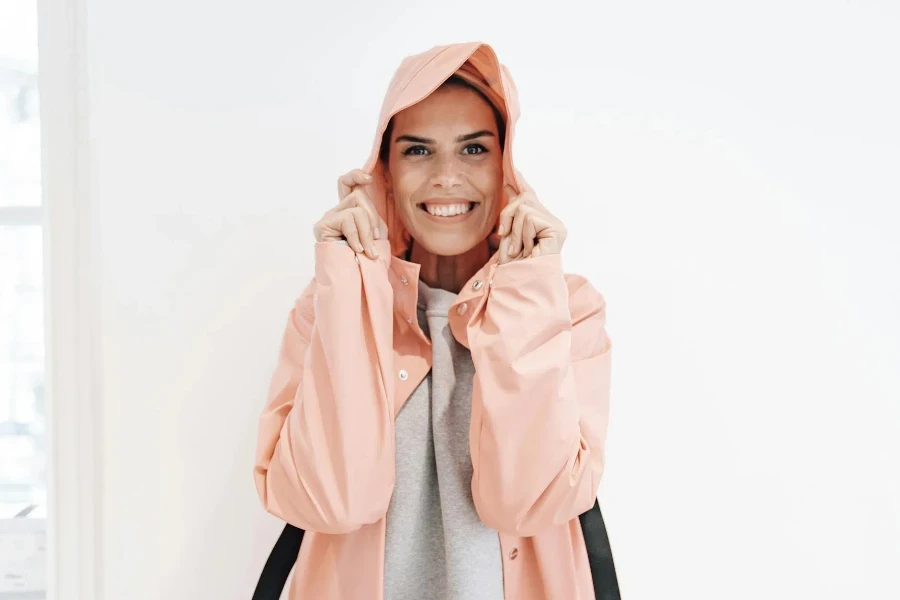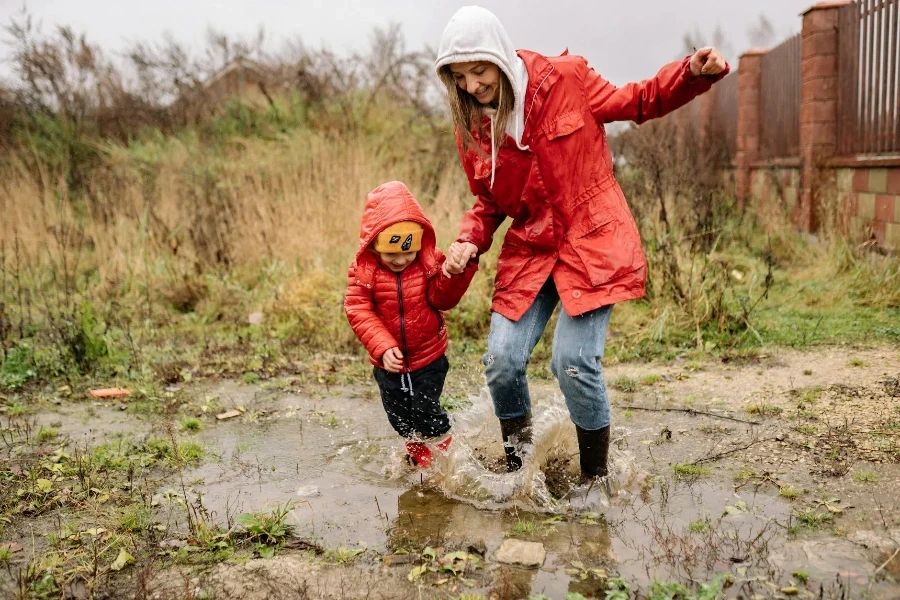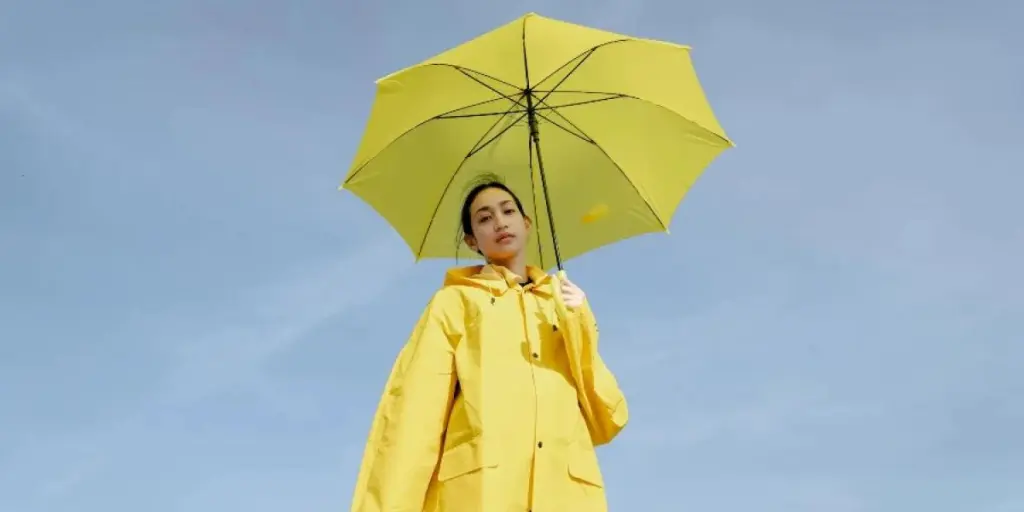Women’s rain jackets have evolved from mere functional outerwear to stylish, versatile pieces that cater to a wide range of consumer preferences. As the market continues to grow, understanding the current trends, key players, and consumer demographics is essential for businesses looking to stay competitive.
Table of Contents:
– Market Overview
– Innovative Materials and Fabrics
– Design and Functionality
– Color and Patterns
Market Overview

Current Market Trends
The market for women’s rain jackets is experiencing significant growth, driven by increasing consumer demand for both functionality and style. According to Statista, the global coats and jackets market is projected to generate a revenue of US$50.69 billion in 2024, with an annual growth rate of 2.45% (CAGR 2024-2028). This growth is fueled by advancements in fabric technology, a rising awareness of sustainable fashion, and the influence of outdoor lifestyle trends.
In the United States, the coats and jackets market generated a revenue of US$7.08 billion in 2024, with a projected annual growth rate of 0.63% (CAGR 2024-2028). The market is expected to reach a volume of 123.1 million pieces by 2028, despite a slight decline in volume in 2025. This indicates a steady demand for high-quality outerwear, including rain jackets, among American consumers.
Key Players in the Industry
The women’s rain jacket market is dominated by several key players who have established themselves through innovation, quality, and brand reputation. Companies like Columbia Sportswear, The North Face, and Patagonia are leading the charge with their commitment to sustainable practices and cutting-edge fabric technologies. These brands have successfully combined functionality with fashion, appealing to a broad demographic of consumers.
Columbia Sportswear, for instance, is renowned for its Omni-Tech technology, which offers waterproof and breathable solutions. The North Face continues to innovate with its FutureLight fabric, providing unparalleled breathability and waterproofing. Patagonia, a pioneer in sustainable fashion, uses recycled materials and ethical manufacturing processes, resonating with environmentally conscious consumers.
Consumer Preferences and Demographics
Consumer preferences in the women’s rain jacket market are increasingly leaning towards sustainability and eco-friendliness. According to Statista, there is a growing demand for sustainable and eco-friendly coats and jackets in the United States, reflecting a broader trend in the fashion industry. Consumers are becoming more aware of the environmental impact of their purchases and are seeking out brands that prioritize ethical practices.
Demographically, the market for women’s rain jackets spans a wide age range, from young adults to older consumers. Younger consumers, particularly millennials and Gen Z, are driving the demand for stylish and functional rain jackets that can be worn in various settings, from urban environments to outdoor adventures. These consumers value versatility, durability, and sustainability in their outerwear choices.
In terms of regional insights, the demand for rain jackets varies significantly across different climates. In regions with high rainfall, such as the Pacific Northwest in the United States, there is a strong demand for high-performance rain jackets. Conversely, in drier regions, consumers may prioritize lightweight and packable options that can be easily stored and used when needed.
Innovative Materials and Fabrics

Sustainable and Eco-Friendly Options
The apparel industry is increasingly focusing on sustainability, and women’s rain jackets are no exception. Brands are now prioritizing eco-friendly materials to cater to the environmentally conscious consumer. According to the Collection Review: Men’s Key Items – Jackets & Outerwear S/S 25, there is a significant shift towards using sustainable fabrics that not only reduce environmental impact but also offer high performance. Recycled polyester, organic cotton, and biodegradable materials are becoming more prevalent in the production of rain jackets. These materials are not only sustainable but also provide the necessary durability and functionality required for outerwear.
Moreover, the use of plant-based dyes and waterless dyeing techniques is gaining traction. These methods significantly reduce water consumption and chemical usage, making the production process more eco-friendly. Brands like Patagonia and The North Face are leading the way by incorporating these sustainable practices into their manufacturing processes, setting a benchmark for others in the industry.
Waterproof and Breathable Technologies
The primary function of a rain jacket is to keep the wearer dry, and advancements in waterproof and breathable technologies have made this possible without compromising comfort. GORE-TEX remains a popular choice for high-performance rain jackets due to its exceptional waterproof and breathable properties. According to a report by EDITED, rain jackets featuring GORE-TEX cost 182% more on average compared to those without the technology, highlighting its premium status in the market.
In addition to GORE-TEX, other technologies like eVent and Pertex Shield are also being utilized. These materials offer similar benefits, providing a balance between waterproofing and breathability. The integration of these technologies ensures that rain jackets can withstand various weather conditions while allowing moisture to escape, keeping the wearer comfortable and dry.
Lightweight and Durable Fabrics
The demand for lightweight yet durable rain jackets is on the rise. Consumers are looking for jackets that are easy to carry and pack, without sacrificing durability. Modern rain jackets are now being made with advanced fabrics that are both lightweight and robust. For instance, nylon and polyester blends are commonly used due to their strength and resistance to wear and tear.
The Collection Review: Men’s Key Items – Jackets & Outerwear S/S 25 highlights the use of technical fabrics that offer enhanced durability while maintaining a lightweight profile. These fabrics are often treated with durable water repellent (DWR) coatings to enhance their water resistance. Additionally, the use of ripstop fabrics, which are woven with a reinforcing technique to prevent tears, is becoming more common in the production of rain jackets.
Design and Functionality

Stylish and Practical Designs
Rain jackets are no longer just about functionality; they are also a fashion statement. The trend towards stylish and practical designs is evident in the latest collections. According to the Collection Review: Men’s Key Items – Jackets & Outerwear S/S 25, classic styles like the trench coat and bomber jacket are being reworked with modern design elements. These updated designs incorporate retro patterns, intricate embellishments, and workwear detailing, making them both functional and fashionable.
Designers are also focusing on creating versatile pieces that can transition seamlessly from urban to outdoor settings. This hybrid urban-to-outdoor styling is characterized by sleek silhouettes, contemporary cuts, and innovative design details that enhance both aesthetics and functionality.
Features Enhancing Comfort and Usability
Comfort and usability are key considerations in the design of rain jackets. Features such as adjustable hoods, cuffs, and hemlines allow for a customized fit, ensuring maximum comfort. Ventilation options, such as underarm zippers and mesh linings, enhance breathability, preventing overheating during physical activities.
Pockets are another important feature, providing convenient storage options for essentials. The Collection Review: Men’s Key Items – Jackets & Outerwear S/S 25 notes the prevalence of cargo pockets and four-pocket designs, which add both functionality and a stylish touch to rain jackets. Additionally, features like packable designs, where the jacket can be folded into its own pocket or a small pouch, are becoming increasingly popular for their convenience and portability.
Seasonal Variations and Adaptations
Rain jackets are designed to cater to different seasons and weather conditions. For instance, lightweight and breathable jackets are ideal for spring and summer, while insulated and lined jackets are better suited for fall and winter. The Collection Review: Men’s Key Items – Jackets & Outerwear S/S 25 emphasizes the importance of transseasonal versatility, with designs that can be adapted for various weather conditions.
Seasonal variations also influence the choice of materials and features. For example, jackets designed for colder months may include thermal linings, while those for warmer months focus on breathability and ventilation. This adaptability ensures that rain jackets remain functional and comfortable throughout the year.
Color and Patterns

Popular Color Trends
Color trends play a significant role in the appeal of rain jackets. According to the Collection Review: Men’s Key Items – Jackets & Outerwear S/S 25, there is a growing preference for neutral tones and muted colors, which offer a timeless and versatile look. Shades like beige, olive, and navy are popular choices, providing a sophisticated and understated aesthetic.
However, bold and vibrant colors are also making a statement. Bright hues like red, yellow, and blue add a pop of color to rainy days, making the wearer stand out. These colors are often used in combination with reflective details for added visibility and safety.
Eye-Catching Patterns and Prints
Patterns and prints are another way to add visual interest to rain jackets. The Collection Review: Men’s Key Items – Jackets & Outerwear S/S 25 highlights the use of retro patterns, geometric prints, and floral designs. These eye-catching patterns not only enhance the aesthetic appeal of the jackets but also reflect current fashion trends.
Designers are also experimenting with color blocking and contrasting trims, creating unique and stylish looks. These design elements add a modern twist to classic rain jacket styles, making them more appealing to fashion-forward consumers.
Cultural Influences on Design Choices
Cultural influences play a significant role in shaping design choices for rain jackets. According to the Collection Review: Men’s Key Items – Jackets & Outerwear S/S 25, there is a growing trend towards incorporating cultural elements into designs. This includes the use of traditional patterns, motifs, and color palettes that reflect different cultural heritages.
For instance, Japanese-inspired designs with minimalist aesthetics and intricate detailing are gaining popularity. Similarly, African prints and patterns are being incorporated into rain jackets, adding a touch of cultural richness and diversity to the designs. These cultural influences not only enhance the visual appeal of the jackets but also celebrate and promote cultural diversity in fashion.
Conclusion
The evolution of women’s rain jackets reflects a perfect blend of innovation, functionality, and style. With advancements in sustainable materials, waterproof technologies, and lightweight fabrics, these jackets are designed to meet the demands of modern consumers. The focus on stylish and practical designs, enhanced comfort features, and seasonal adaptability ensures that rain jackets remain a wardrobe staple throughout the year. As we look to the future, the integration of cultural influences and the continuous push for sustainability will further shape the trends and innovations in the apparel industry, making rain jackets not just a necessity but a fashion-forward choice.





 Afrikaans
Afrikaans አማርኛ
አማርኛ العربية
العربية বাংলা
বাংলা Nederlands
Nederlands English
English Français
Français Deutsch
Deutsch हिन्दी
हिन्दी Bahasa Indonesia
Bahasa Indonesia Italiano
Italiano 日本語
日本語 한국어
한국어 Bahasa Melayu
Bahasa Melayu മലയാളം
മലയാളം پښتو
پښتو فارسی
فارسی Polski
Polski Português
Português Русский
Русский Español
Español Kiswahili
Kiswahili ไทย
ไทย Türkçe
Türkçe اردو
اردو Tiếng Việt
Tiếng Việt isiXhosa
isiXhosa Zulu
Zulu